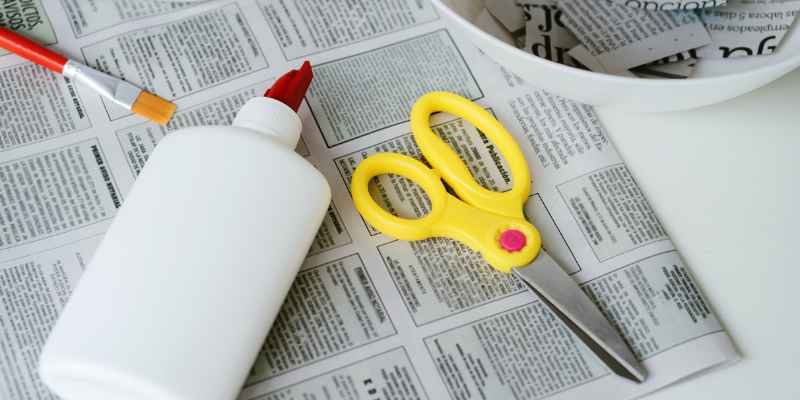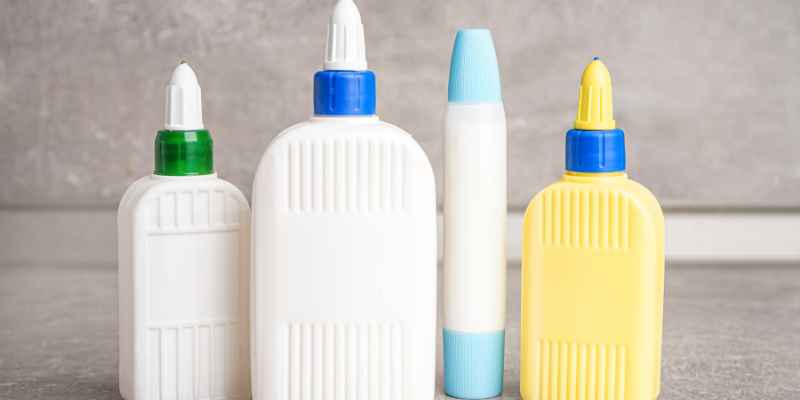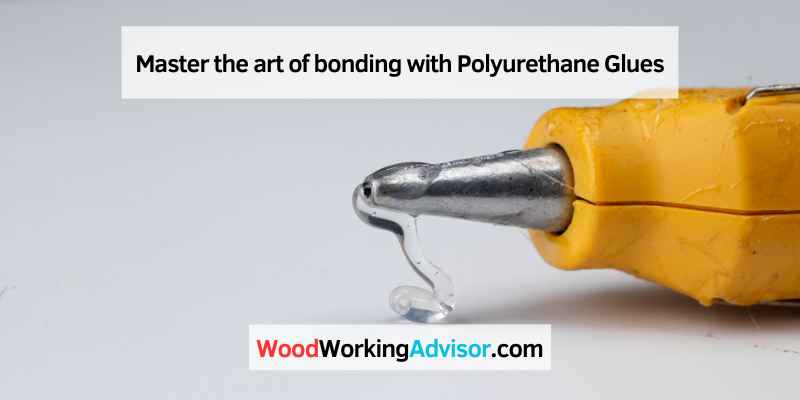Polyurethane glues are versatile adhesives that can be used to bond wood, metal, leather, tile, glass, rubber, brick, and concrete. However, they are not effective with plastics like polyethylene, polypropylene, or chemically-created materials like Teflon.
Polyurethane glues, also known as polyurethane adhesives, are incredibly useful in a wide range of applications due to their ability to form strong bonds with various materials. They are often used as mounting glue to attach components to metal, plastic or glass.
Additionally, they can be made into an expanding foam for insulation and crack sealing. While they offer many benefits, there are also limitations to their use. They can be expensive, difficult to clean up and may not be suitable for all applications. We will explore the strengths and limitations of polyurethane glues and share tips on how to use them effectively.

Types Of Polyurethane Glues
Polyurethane glues are versatile and used for various applications. They can be used as mounting glue, expanding foam for insulation and sealing cracks, and bonding wood, metal, leather, tile, glass, rubber, brick, and concrete. However, they can be expensive, difficult to clean up, and not effective with certain materials like polyethylene and Teflon.
Polyurethane glues, or simply PU glues, are the adhesives of choice for many DIY and professional bonding projects. These versatile glues come in different formulations, and each type is designed to meet specific bonding requirements. Knowing the types of polyurethane glues available in the market and their respective strengths will help you make an informed choice when picking a glue for your next project. Let’s dive in and explore the different types of polyurethane glues available:
Liquid Polyurethane Glue
Liquid polyurethane glue is a moisture-curing type of glue that sets by reacting with water. This glue is ideal for bonding wood, leather, ceramics, and almost any other material that requires excellent holding strength and water resistance. Liquid polyurethane glue is also popularly used for filling voids and gaps in wood joints, as it expands slightly upon curing, thus achieving a perfect fit. The Gorilla glue, Titebond, and Loctite brands offer some of the best liquid polyurethane glue in the market for woodworking and general-purpose projects.
Polyurethane Construction Adhesive
Polyurethane construction adhesive is a heavy-duty adhesive that is highly resistant to water, chemicals, and weathering. This type of adhesive is ideal for bonding construction materials such as metal, concrete, brick, and drywall. Polyurethane construction adhesive provides a strong and permanent bond that can withstand heavy loads and extreme temperatures. Products like Loctite PL Premium and Liquid Nails Polyurethane offer reliable and effective construction adhesive solutions.
In conclusion, choosing the right type of polyurethane glue can make or break your bonding project. Liquid polyurethane glue is the go-to for woodworking, while polyurethane construction adhesive is ideal for heavy-duty construction applications. With the proper application technique and adequate surface preparation, polyurethane glue can provide excellent holding power and durability.
Benefits Of Using Polyurethane Glue
Polyurethane glue is a versatile adhesive that can bond a variety of materials such as wood, metal, leather, and glass. Its expanding foam feature can also be used for insulation and sealing of cracks. However, it can be difficult and expensive to clean up and not suitable for some materials like polyethylene and polypropylene.
Polyurethane glue, commonly known as PU glue, is a versatile adhesive that is widely used in different applications due to its many benefits. Below are some of the advantages of using polyurethane glue that make it an excellent choice for bonding various materials.
High Strength Bonding
Polyurethane glue creates a strong and durable bond that can withstand tension, shear, and compression forces. Its adhesive properties are superior to other types of glue, making it ideal for bonding materials that need a high-strength bond.
Gap Filling Ability
One of the most significant advantages of polyurethane glue is its gap-filling ability. Unlike other adhesives, which require the surfaces to be clean and fit together tightly, polyurethane glue can fill in gaps and spaces between the materials being bonded. This feature allows it to be used to bond uneven or irregular surfaces.
Can Be Used On Multiple Surfaces
Polyurethane glue can be used on various surfaces such as wood, metal, glass, plastic, ceramics, and even leather. This feature makes it a versatile adhesive that can be used in multiple applications. It also means that you don’t have to purchase separate adhesives for each surface you want to bond.
In conclusion, polyurethane glue is an excellent adhesive due to its high-strength bonding, gap-filling ability, and the ability to be used on multiple surfaces. It is a versatile adhesive that should be in every DIY and professional’s toolbox.
Tips For Working With Polyurethane Glue
Polyurethane glues are a versatile adhesive option for a range of materials including wood, metal, leather, and even glass. When working with polyurethane glue, it is important to follow proper storage and handling protocols, and consider factors such as gap-filling and expansion before use.
Polyurethane glue, also known as PU glue, is a strong adhesive that is often used for woodworking and other DIY projects. It provides a strong bond that can withstand the test of time, but working with it can be tricky. Follow these tips for working with polyurethane glue to ensure that your projects turn out perfectly.
Do’s and Don’ts of Working with Polyurethane Glue:
Do:
– Use gloves when handling polyurethane glue since it can be tough to remove from skin.
– Always wear eye protection when working with this adhesive.
– Apply the glue sparingly since it expands as it dries.
– Clamp or apply pressure on the items being glued together to ensure a strong bond.
– Sand the surfaces to be glued lightly before applying the adhesive to improve their grip.
– Follow the manufacturer’s instructions to ensure the best results.
– Clean any excess glue immediately with a damp cloth.
– Allow adequate drying time before removing clamps or applying any type of stress on the items being glued.
Don’t:
– Overapply the glue as it expands as it dries and may create a mess.
– Ingest the adhesive or work in a poorly-ventilated area.
– Try to remove dried glue with a sharp object as it could damage the surface.
– Rely on polyurethane glue to bond surfaces that are continually exposed to water.
Using Polyurethane Glue on Oily Surfaces:
One of the challenges of working with polyurethane glue is that it doesn’t adhere as well to oily surfaces. To get around this, sand the surface to remove some of the oil, or use an alcohol-based cleaner to remove the oil before applying the glue.
Storing Polyurethane Glue Properly:
To get the best results from your polyurethane glue, ensure that it is stored correctly. Store the adhesive in a cool, dry place and make sure to keep the cap tightly closed to prevent the glue from drying out. Polyurethane glue doesn’t have a long shelf life once opened, so make sure to check the expiration date before using it.
In conclusion, working with polyurethane glue requires attention to detail and following the manufacturer’s instructions correctly. By following the tips outlined above, you can ensure that your projects bond together perfectly and last for a long time.
Polyurethane Glue Hacks
Polyurethane glue, commonly known as PU glue, is a versatile adhesive that can be used to bond a variety of materials such as wood, metal, leather, tile, glass, and rubber. It is also effective for insulation and sealing of cracks. However, using PU glue can be a challenge due to its expanding nature and longer setting time. Here are some neat tricks to make working with PU glue easier.
Neat Trick For Working With Polyurethane Glue
- Preparation is key: Before applying PU glue, make sure the surfaces to be bonded are clean, dry, and free of any grease or oil. Any dirt or moisture can affect the adhesion strength of the glue.
- Apply sparingly: PU glue expands as it cures, so it’s important to apply it sparingly to avoid any excess. A thin layer of glue is enough to create a strong bond.
- Use masking tape: To avoid excess glue spreading to unintended areas, use masking tape to create a border around the bonding area. Remove the tape before the glue sets.
- Add moisture: If the surfaces to be bonded are dry, adding a few drops of water to one of the surfaces can help activate the glue and improve its adhesion strength.
- Sanding: Sanding the surfaces to be bonded can improve the adhesion strength of the PU glue, especially for porous materials like wood.
Conclusion
Polyurethane glue is a versatile and strong adhesive that can be used for a variety of applications. By following these neat tricks, working with PU glue can be easier and more effective. Remember to always read the manufacturer’s instructions before using any adhesives, and wear protective gear when necessary.
Recommended Brands Of Polyurethane Glue
Polyurethane glues are great for attaching components to metal, plastic, glass, and more. Recommended brands include Loctite PL Premium, Liquid Nails Polyurethane, and Gorilla Glue, which are all available at Lowes and other retailers.
If you are looking for a reliable adhesive that can bond almost any material together, then look no further than polyurethane glue. This type of glue is fast becoming the adhesive of choice for woodworkers, carpenters, and DIY enthusiasts alike. With its exceptional bonding capabilities, water resistance, and superior strength, polyurethane glue can provide robust and long-lasting results.
Overview of Recommended Brands
There are several brands of polyurethane glue available in the market, each with its unique set of properties and intended use. However, following are some of the top recommended brands based on consumer rating, expert reviews, and market popularity:
1. Loctite PL Premium Polyurethane Construction Adhesive: This brand of polyurethane glue is known for its exceptional bonding strength and high viscosity. It can bond almost any material, including wood, metal, and plastic. Its fast-grabbing properties make it ideal for heavy-duty applications that require quick bonding and minimum clamping time.
2. Liquid Nails Polyurethane Construction Adhesive: This brand of polyurethane glue is an all-purpose adhesive that provides superior bonding strength. Its low-odor and water-resistant formula make it ideal for indoor and outdoor applications. Additionally, it can bond to a wide range of materials, including metal, wood, ceramics, stone, and more.
3. Gorilla Glue: This brand of polyurethane glue is one of the most popular brands in the market, known for its exceptional bonding strength and versatility. Its unique foaming ability helps to fill gaps and cracks, making it an ideal choice for woodworking and carpentry applications. Gorilla glue can bond almost any material, including wood, metal, ceramic, foam, and more.
Comparison of Different Brands
When it comes to choosing the right polyurethane glue, there are several factors you should consider, including bonding strength, curing time, viscosity, and compatibility with different materials. To help you make an informed decision, here is a comparison of different brands of polyurethane glue:
Brand | Bonding Strength | Curing Time
Loctite PL Premium Polyurethane Construction Adhesive | High | 24 hours
Liquid Nails Polyurethane Construction Adhesive | High | 24-48 hours
Gorilla Glue | High | 24 hours
As you can see, all these brands offer exceptional bonding strength and require a relatively long curing time. However, Loctite PL Premium may take slightly longer to cure compared to others. Additionally, Gorilla glue’s foaming ability makes it ideal for filling gaps and cracks, whereas Liquid Nails is better suited for indoor and outdoor applications due to its water-resistant formula.
In conclusion, Polyurethane glue is an excellent adhesive for bonding almost any material, providing superior strength, water resistance, and long-lasting results. When choosing a brand, consider factors such as bonding strength, curing time, viscosity, and compatibility with different materials. Regardless of the brand you choose, the above-recommended brands of polyurethane glue are highly rated and proven to deliver excellent results.

Limitations Of Polyurethane Glue
Polyurethane glues have many advantages, including high versatility, bonding strength, and gap-filling capabilities. However, they also have some limitations, including being more expensive than other types of adhesive, difficult to clean up, and not effective for bonding some materials like plastics and chemically-created materials.
Polyurethane glue, also known as PU glue, is a popular choice for DIYers and professionals alike due to its superior bonding strength and water resistance. However, like any adhesive, it has its limitations. Let’s take a closer look at the disadvantages of polyurethane glue and the surfaces it does not stick to.
Disadvantages of Polyurethane Glue
One major disadvantage of polyurethane glue is its high cost compared to other types of adhesives such as PVA glue. In addition, PU glue is more difficult to clean up, and overselling to customers who do not need it is common.
Another limitation of PU glue is its long setting time, which can take up to 24 hours to fully cure. This means that clamping is required during this time, which may not be practical for some projects.
Surfaces Polyurethane Glue does not Stick to
Although polyurethane glue can bond a variety of materials such as wood, metal, leather, tile, glass, rubber, brick, and concrete, it does not effectively stick to certain plastics such as polyethylene and polypropylene, as well as some types of silicone and Teflon.
In conclusion, while polyurethane glue is a strong and versatile adhesive, it has its limitations that should be taken into consideration for specific applications. Knowing the surfaces that PU glue doesn’t stick to can help prevent issues with adhesion.
Frequently Asked Questions On Polyurethane Glues
What Is Polyurethane Glue Best For?
Polyurethane glue is best for attaching components to metal, plastic, or glass. It can be used for insulation and sealing of cracks when made into expanding foam. It is not effective for bonding plastics, such as polyethylene and polypropylene, or chemically-created materials like Teflon.
However, it is well suited for exterior applications, such as sign building and outdoor furniture construction.
What Is One Disadvantage Of Polyurethane Based Glues?
One disadvantage of polyurethane based glues is that they are expensive and difficult to clean up compared to PVA glues. Additionally, they are often oversold to users who don’t necessarily require them. They are better suited for outdoor applications such as building signs and furniture.
What Does Polyurethane Glue Not Stick To?
Polyurethane glue does not stick to plastics like polyethylene or polypropylene, or to chemically-created materials like Teflon. It can bond wood, metal, leather, tile, glass, rubber, brick, and concrete.
Is Gorilla Glue Clear A Polyurethane Glue?
Yes, Gorilla Glue Clear is a polyurethane glue.
Conclusion
Polyurethane glue is an excellent option for various applications such as bonding metals, plastics, and even glass. It can also be used for insulation and sealing of cracks, making it a versatile adhesive for both indoor and outdoor use. However, due to its higher cost and difficulty of cleanup, it may not be the best option for everyone.
With careful consideration of its strengths and limitations, polyurethane glue can prove to be a reliable tool for any DIY enthusiast or professional woodworker. Try it out and see the results for yourself!


